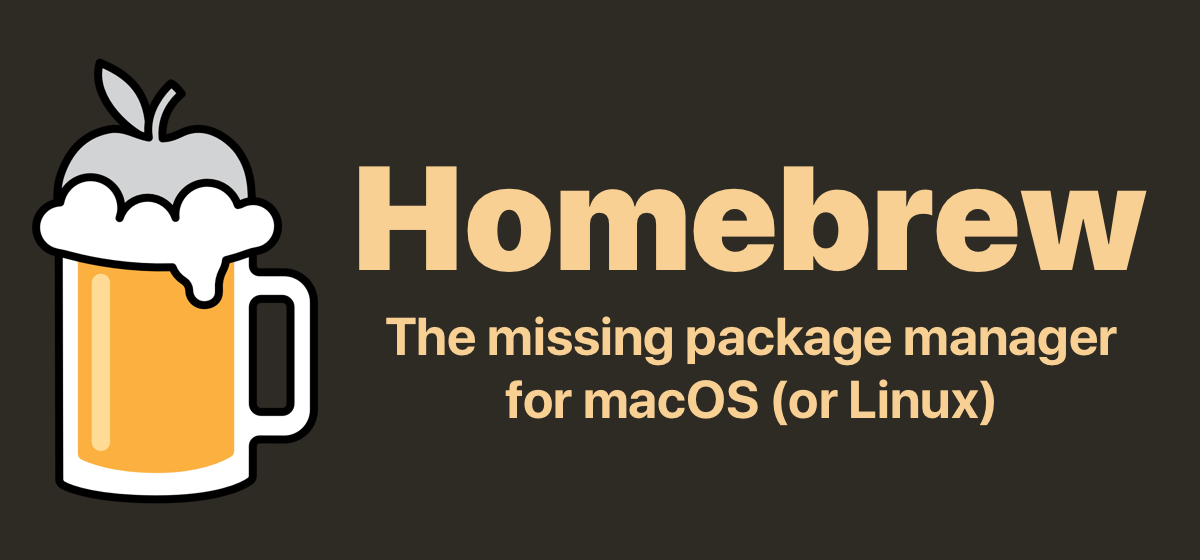Options were passed to the install command, i.e. Brew install will use a bottled version of the formula, but brew install -enable-bar will trigger a source build. The -build-from-source option is invoked. The machine is not running a supported version of macOS as all bottled builds are generated only for supported macOS. Instead, the Brew application is compiled to native code and linked with a compatible Brew runtime library. Because of this, applications cannot be tested for platform bugs related to memory alignment and various firmware related glitches without a Brew handset operating in test mode. Like any other application, you can find it by going into Finder, navigating to the Applications folder, and then into the Utilities folder. From here, double-click the Terminal application to open it up.
-->You can't run your code until all missing references are resolved.

This error has the following causes and solutions:
A referenced project could not be found, or a referencedobject library corresponding to the language of the project could not be found.
Unresolved references are prefixed with MISSING in the References dialog box. Select the missing reference to display the path and language of the missing project or library. Follow these steps to resolve the reference or references:
To resolve the references
Display the References dialog box.
Select the missing reference.
Start the Object Browser.
Use the Browse dialog box to find the missing reference.
Click OK.
Repeat the preceding steps until all missing references are resolved.
Once you find a missing item, the MISSING prefix is removed to indicate that the link is reestablished. If the file name of a referenced project has changed, a new reference is added, and the old reference must be removed.To remove a reference that is no longer required, simply clear the check box next to the unnecessary reference. Note that the references to the Visual Basic object library and host-application object library can't be removed.
Applications may support different language versions of their object libraries. To find out which language version is required, click the reference and check the language indicated at the bottom of the dialog box.Object libraries may be standalone files with the extension .OLB or they can be integrated into a dynamic-link library (DLL) They can exist in different versions for each platform. Therefore, when projects are moved across platforms, for example, from Macintosh to Microsoft Windows, the correct language version of the referenced library for that platform must be available in the location specified in your host application documentation.
Object library file names are generally constructed as follows:
Windows (version 3.1 and earlier): Application Code + Language Code + [Version].OLB. For example: The object library for French Visual Basic for Applications, Version 2 was vafr2.olb. The French Microsoft Excel 5.0 object library was xlfr50.olb.
Macintosh: Application Name Language Code [Version] OLB. For example: The object library for French Visual Basic for Applications, Version 2 was VA FR 2 OLB. The French Microsoft Excel 5.0 object library was MS Excel FR 50 OLB.
If you can't find a missing project or library on your system, contact the referencing project's author. If the missing library is a Microsoft application object library, you can obtain it as follows:
If you have access to Microsoft electronic technical support services, refer to the technical support section of this Help file. Under electronic services, you will find instructions on how to use the appropriate service option.
If you don't have access to Microsoft electronic technical support services, Microsoft object libraries are available upon request as an application note from Microsoft. Information on how to contact your local Microsoft product support organization is also available in the technical support section of this Help file.
For additional information, select the item in question and press F1 (in Windows) or HELP (on the Macintosh).
Note
Interested in developing solutions that extend the Office experience across multiple platforms? Check out the new Office Add-ins model. Office Add-ins have a small footprint compared to VSTO Add-ins and solutions, and you can build them by using almost any web programming technology, such as HTML5, JavaScript, CSS3, and XML.
Application Cannot Find Library Installed By Brewing Company
Support and feedback

Have questions or feedback about Office VBA or this documentation? Please see Office VBA support and feedback for guidance about the ways you can receive support and provide feedback.
Instructions for a supported install of Homebrew are on the homepage.
This script installs Homebrew to its preferred prefix (/usr/localfor macOS Intel, /opt/homebrew for Apple Silicon and /home/linuxbrew/.linuxbrew for Linux) so thatyou don’t need sudo when youbrew install. It is a careful script; it can be run even if you have stuffinstalled in the preferred prefix already. It tells you exactly what it will do beforeit does it too. You have to confirm everything it will do before it starts.

macOS Requirements
- A 64-bit Intel CPU or Apple Silicon CPU 1
- macOS Mojave (10.14) (or higher) 2
- Command Line Tools (CLT) for Xcode:
xcode-select --install,developer.apple.com/downloads orXcode3 - A Bourne-compatible shell for installation (e.g.
bashorzsh) 4
Git Remote Mirroring
You can set HOMEBREW_BREW_GIT_REMOTE and/or HOMEBREW_CORE_GIT_REMOTE in your shell environment to use geolocalized Git mirrors to speed up Homebrew’s installation with this script and, after installation, brew update.
The default Git remote will be used if the corresponding environment variable is unset.
Alternative Installs
Linux or Windows 10 Subsystem for Linux

Check out the Homebrew on Linux installation documentation.
Untar anywhere
Just extract (or git clone) Homebrew wherever you want. Just avoid:
- Directories with names that contain spaces. Homebrew itself can handle spaces, but many build scripts cannot.
/tmpsubdirectories because Homebrew gets upset./swand/opt/localbecause build scripts get confused when Homebrew is there instead of Fink or MacPorts, respectively.
However do yourself a favour and use the installer to install to the default prefix. Some things maynot build when installed elsewhere. One of the reasons Homebrew justworks relative to the competition is because we recommend installinghere. Pick another prefix at your peril!
Multiple installations
Create a Homebrew installation wherever you extract the tarball. Whichever brew command is called is where the packages will be installed. You can use this as you see fit, e.g. a system set of libs in the default prefix and tweaked formulae for development in ~/homebrew.
Uninstallation
Uninstallation is documented in the FAQ.
1 For 32-bit or PPC support seeTigerbrew.
Application Cannot Find Library Installed By Breweries
2 10.14 or higher is recommended. 10.9–10.13 aresupported on a best-effort basis. For 10.4-10.6 seeTigerbrew.
3 Most formulae require a compiler. A handfulrequire a full Xcode installation. You can install Xcode, the CLT, or both;Homebrew supports all three configurations. Downloading Xcode may require anApple Developer account on older versions of Mac OS X. Sign up for freehere.
Application Cannot Find Library Installed By Brewery
4 The one-liner installation method found onbrew.sh requires a Bourne-compatible shell (e.g. bash orzsh). Notably, fish, tcsh and csh will not work.